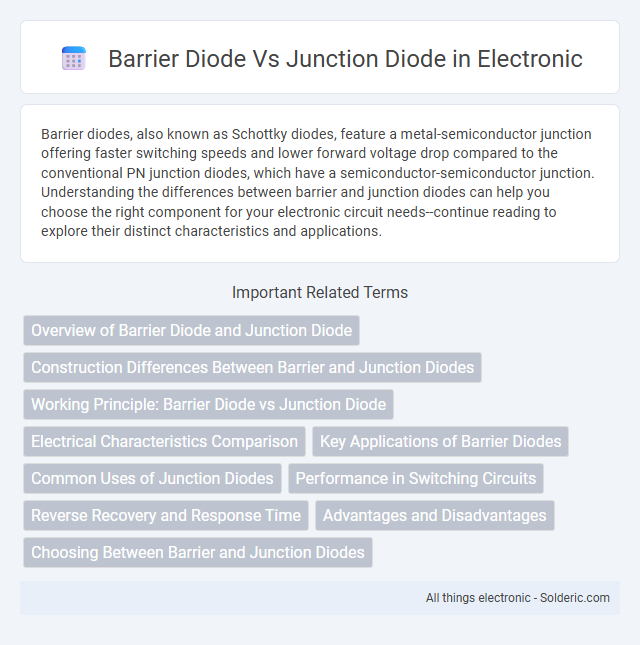Barrier diodes, also known as Schottky diodes, feature a metal-semiconductor junction offering faster switching speeds and lower forward voltage drop compared to the conventional PN junction diodes, which have a semiconductor-semiconductor junction. Understanding the differences between barrier and junction diodes can help you choose the right component for your electronic circuit needs--continue reading to explore their distinct characteristics and applications.
Comparison Table
| Feature | Barrier Diode | Junction Diode |
|---|---|---|
| Structure | Metal-semiconductor junction | PN semiconductor junction |
| Operation Principle | Schottky barrier and majority carrier conduction | PN junction formed by majority and minority carriers |
| Forward Voltage Drop | Lower, typically 0.2-0.3 V | Higher, typically 0.6-0.7 V |
| Switching Speed | Faster switching due to majority carrier conduction | Slower switching affected by minority carriers |
| Applications | High-speed switching, RF detection, clamping circuits | Rectification, signal demodulation, general-purpose use |
| Reverse Recovery Time | Very short, ideal for high-frequency operation | Longer due to minority carrier storage |
Overview of Barrier Diode and Junction Diode
Barrier diodes, also known as Schottky diodes, feature a metal-semiconductor junction that allows for faster switching speeds and lower forward voltage drop compared to junction diodes, which have a p-n semiconductor junction. Junction diodes are commonly used for rectification in power supplies, while barrier diodes excel in high-frequency and low-noise applications. Understanding the differences in construction and electrical characteristics can help you choose the right diode for your circuit's requirements.
Construction Differences Between Barrier and Junction Diodes
Barrier diodes feature a metal-semiconductor junction known as a Schottky barrier, whereas junction diodes are constructed with a p-n semiconductor junction formed by doping regions with acceptor and donor impurities. The barrier diode's metal-semiconductor interface allows for faster switching speeds and lower forward voltage drops compared to the p-n junction's higher built-in potential and slower charge carrier recombination. These fundamental construction differences impact their electrical characteristics and suitability for high-frequency or rectification applications.
Working Principle: Barrier Diode vs Junction Diode
The Barrier Diode operates based on the metal-semiconductor junction where electrons encounter a potential barrier that allows current flow primarily in one direction, ideal for high-speed switching and detection applications. In contrast, the Junction Diode works through a p-n semiconductor junction where charge carriers recombine, enabling controlled current flow with a distinct forward and reverse bias characteristic used in rectification and signal modulation. The intrinsic barrier in the Barrier Diode results in faster response times compared to the traditional Junction Diode due to reduced charge storage effects.
Electrical Characteristics Comparison
Barrier diodes exhibit lower forward voltage drops, typically around 0.3V, compared to junction diodes which have forward drops near 0.7V, making barrier diodes ideal for high-frequency switching applications. The reverse recovery time of barrier diodes is significantly faster, often in nanoseconds, whereas junction diodes may take microseconds, enhancing performance in fast switching circuits. Your choice between these diodes depends on the required switching speed, forward voltage drop, and frequency response in your electronic design.
Key Applications of Barrier Diodes
Barrier diodes are primarily used in high-frequency and microwave applications such as detectors, mixers, and fast switching circuits due to their low forward voltage and minimal charge storage, which allows for rapid response times. In contrast, junction diodes serve mainly in rectification, voltage regulation, and signal demodulation where slower switching speeds are acceptable. You will find barrier diodes indispensable in RF circuits, voltage multipliers, and parametric oscillators where performance at high frequencies is critical.
Common Uses of Junction Diodes
Junction diodes are widely used in rectification processes to convert alternating current (AC) to direct current (DC) in power supplies. They function effectively as signal demodulators and voltage limiters in communication circuits. Your electronic designs benefit from their reliable switching and protection roles within various low-voltage applications.
Performance in Switching Circuits
Barrier diodes exhibit faster switching speeds than junction diodes due to their metal-semiconductor junction, resulting in lower junction capacitance and reduced charge storage. This makes barrier diodes ideal for high-frequency switching applications where rapid response is critical. Conversely, junction diodes have slower switching characteristics caused by minority carrier storage, limiting their effectiveness in high-speed switching circuits.
Reverse Recovery and Response Time
Barrier diodes exhibit significantly faster reverse recovery times compared to junction diodes due to their metal-semiconductor junction, which minimizes charge storage and allows for rapid switching. The response time of barrier diodes is typically in the nanosecond range, making them ideal for high-frequency applications, whereas junction diodes have longer recovery times caused by charge recombination in the p-n junction. Consequently, barrier diodes are preferred in circuits requiring minimal reverse recovery delay and faster signal processing.
Advantages and Disadvantages
Barrier diodes offer advantages such as fast switching speeds and low forward voltage drop, making them ideal for high-frequency applications, but they have limited current handling capability compared to junction diodes. Junction diodes provide higher current ratings and robustness for general-purpose rectification but exhibit slower recovery times and higher forward voltage drops. Understanding these trade-offs helps you select the optimal diode type for your specific electronic circuit requirements.
Choosing Between Barrier and Junction Diodes
Choosing between barrier diodes and junction diodes depends on the application requirements such as switching speed, forward voltage drop, and leakage current. Barrier diodes, or Schottky diodes, offer lower forward voltage (typically 0.2 to 0.3 volts) and faster switching speeds, making them ideal for high-frequency and low-voltage circuits. Junction diodes generally have higher forward voltage drops (around 0.7 volts) and slower switching but provide better reverse voltage tolerance and are commonly used in general-purpose rectification.
Barrier diode vs Junction diode Infographic

 solderic.com
solderic.com